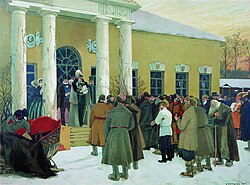Emancipation reform of 1861

The Emancipation Reform of 1861 in Russia, also known as the Emancipation Edict of Russia, (Russian: Крестьянская реформа 1861 года – "peasants' reform of 1861") was the first and most important of the liberal reforms passed during the reign (1855–1881) of Emperor Alexander II of Russia. The reform effectively abolished serfdom throughout the Russian Empire.
The 1861 Emancipation Manifesto proclaimed the emancipation of the serfs on private estates and of the domestic (household) serfs. By this edict more than 23 million people received their liberty.[1] Serfs gained the full rights of free citizens, including rights to marry without having to gain consent, to own property and to own a business. The Manifesto prescribed that peasants would be able to buy the land from the landlords. Household serfs were the least affected: they gained only their freedom and no land.
In Georgia the emancipation took place later, in 1864, and on much better terms for the nobles than in Russia. The serfs were emancipated in 1861, after a speech given by Tsar Alexander II on 30 March 1856.[2] State owned serfs, i.e., those living on Imperial lands, were emancipated later, in 1866.
Emancipation Reform Of 1861 Media
A 1907 painting by Boris Kustodiev depicting Russian serfs listening to the proclamation of the Emancipation Manifesto in 1861
Peasants Reading the Emancipation Manifesto, an 1873 painting by Grigory Myasoyedov
The Abolition of Serfdom in Russia: Work in Freedom is the Foundation of a State (1914), by Alphonse Mucha, The Slav Epic
Central Bank of Russia coin commemorating the 150th anniversary of the emancipation reform
References
- ↑ Mee, Arthur; Hammerton, J.A.; Innes, Arthur D.; Harmsworth History of the World: Volume 7, 1907, Carmelite House, London; p. 5193.
- ↑ Corrin, Chris; Feihn, Terry (31 July 2015). AQA A-level History Tsarist and Communist Russia: 1855–1964. Hachette UK: Hodder Education; Dynamic Learning. p. 11. ISBN 978-1471837807. Retrieved 8 September 2015.
On 30 March 1856 Alexander II made a speech to the Marshalls of the Nobility in which he signalled the start of a process that led to the abolition of serfdom in 1861.



